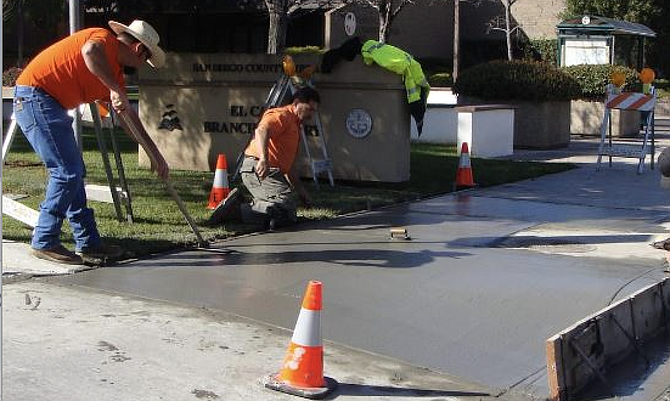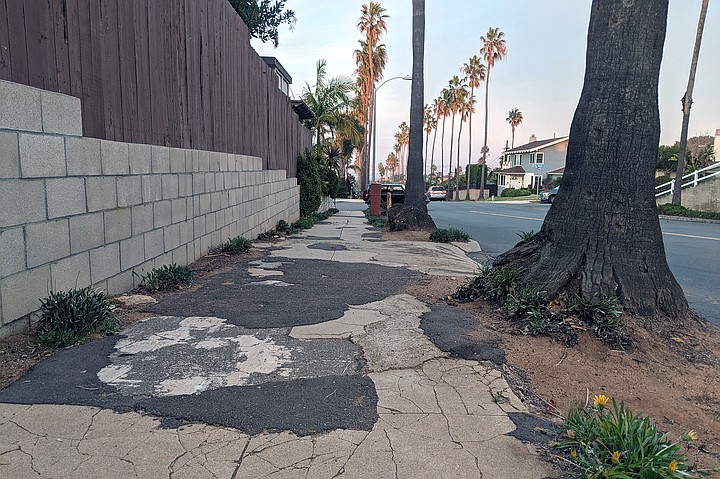 Facebook
Facebook
 X
X
 Instagram
Instagram
 TikTok
TikTok
 Youtube
Youtube

Over a recent weekend, the city received 350 sidewalk service requests. With only two maintenance crews, it's no surprise there's a backlog of 9,000 requests for concrete repairs, mostly sidewalks.
San Diego's 4,600-mile pedestrian network is an important part of its climate action plan. But the paved paths only last 50-80 years, and many are nearing their lifespan, while some of the system's shoulder walkways, in communities like Banker's Hill, Golden Hill and Mission Hills, date to the last century.
A sidewalk assessment completed in 2015 found more than 85,000 locations with major cracks and other defects. Maintenance crews replace about 300 locations each year.
The current estimate of sidewalk need is $185 million dollars based on 37,000 locations known to be in need of replacement, according to Patrick Hadley, deputy director of the transportation department's streets division. The city had previously reported needing $100 million, but it was based on older costs of $2,000 to $3,000 per location.
Inflation and rising wages have now pushed costs up to about $5,000 for each location.
Funding for replacement includes $5 million dollars received in 2019, and another $4 million in fiscal year 2023. At the current level of funding, based on the $185 million dollar need, completing all known repairs would take approximately 20 years, staff said.

However, that figure will shrink. That's because many of the thousands of locations will be the responsibility of the adjacent property owner, thanks to state and highway code.
"People are always shocked when they hear that," Councilmember Joe Lacava said at a recent meeting of the active transportation and infrastructure committee. After all, sidewalks "are part of the city's infrastructure."
And with a permit cost in San Diego of $2,200 - compared to $100-$200 in most cities - it's a significant boost.
But there's a council policy that puts certain maintenance expenses on the city: where parkway trees damage sidewalks, there are grade subsidence, city utility cuts, heat expansion, sidewalk fronting city-owned property, or if there's no abutting property owner.
And the city has a 50-50 cost share program to help those who can't afford the repair, which can range from $1,000 to $5,000. About 30 jobs are completed annually.
Sidewalk work includes ramping, typically sought through the city's Get It Done app or a call to public works. The city's dispatch team will temporarily fix the issue with an asphalt ramp, then refer the site for a more permanent repair, such as slicing or replacement.
When the city determines that a property owner is responsible for the repairs, they send a notice of liability along with information about the cost-share program and permitting.
According to city staff, the main difference between jurisdictions is how they enforce the policy, with some cities putting a lien on properties when homeowners don't do the work.
One option San Diego is looking into is point of sale, where the city would require the repairs when a property is sold. Another is to make it easier for property owners to make their own repairs, possibly even waiving the costly right-of-way permit.


Over a recent weekend, the city received 350 sidewalk service requests. With only two maintenance crews, it's no surprise there's a backlog of 9,000 requests for concrete repairs, mostly sidewalks.
San Diego's 4,600-mile pedestrian network is an important part of its climate action plan. But the paved paths only last 50-80 years, and many are nearing their lifespan, while some of the system's shoulder walkways, in communities like Banker's Hill, Golden Hill and Mission Hills, date to the last century.
A sidewalk assessment completed in 2015 found more than 85,000 locations with major cracks and other defects. Maintenance crews replace about 300 locations each year.
The current estimate of sidewalk need is $185 million dollars based on 37,000 locations known to be in need of replacement, according to Patrick Hadley, deputy director of the transportation department's streets division. The city had previously reported needing $100 million, but it was based on older costs of $2,000 to $3,000 per location.
Inflation and rising wages have now pushed costs up to about $5,000 for each location.
Funding for replacement includes $5 million dollars received in 2019, and another $4 million in fiscal year 2023. At the current level of funding, based on the $185 million dollar need, completing all known repairs would take approximately 20 years, staff said.

However, that figure will shrink. That's because many of the thousands of locations will be the responsibility of the adjacent property owner, thanks to state and highway code.
"People are always shocked when they hear that," Councilmember Joe Lacava said at a recent meeting of the active transportation and infrastructure committee. After all, sidewalks "are part of the city's infrastructure."
And with a permit cost in San Diego of $2,200 - compared to $100-$200 in most cities - it's a significant boost.
But there's a council policy that puts certain maintenance expenses on the city: where parkway trees damage sidewalks, there are grade subsidence, city utility cuts, heat expansion, sidewalk fronting city-owned property, or if there's no abutting property owner.
And the city has a 50-50 cost share program to help those who can't afford the repair, which can range from $1,000 to $5,000. About 30 jobs are completed annually.
Sidewalk work includes ramping, typically sought through the city's Get It Done app or a call to public works. The city's dispatch team will temporarily fix the issue with an asphalt ramp, then refer the site for a more permanent repair, such as slicing or replacement.
When the city determines that a property owner is responsible for the repairs, they send a notice of liability along with information about the cost-share program and permitting.
According to city staff, the main difference between jurisdictions is how they enforce the policy, with some cities putting a lien on properties when homeowners don't do the work.
One option San Diego is looking into is point of sale, where the city would require the repairs when a property is sold. Another is to make it easier for property owners to make their own repairs, possibly even waiving the costly right-of-way permit.
Comments